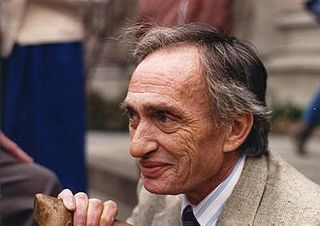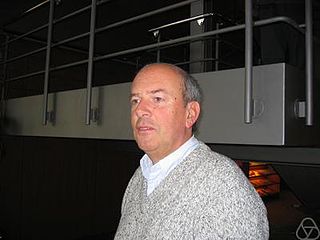In algebra, ring theory is the study of rings, algebraic structures in which addition and multiplication are defined and have similar properties to those operations defined for the integers. Ring theory studies the structure of rings; their representations, or, in different language, modules; special classes of rings ; related structures like rngs; as well as an array of properties that prove to be of interest both within the theory itself and for its applications, such as homological properties and polynomial identities.
Invariant theory is a branch of abstract algebra dealing with actions of groups on algebraic varieties, such as vector spaces, from the point of view of their effect on functions. Classically, the theory dealt with the question of explicit description of polynomial functions that do not change, or are invariant, under the transformations from a given linear group. For example, if we consider the action of the special linear group SLn on the space of n by n matrices by left multiplication, then the determinant is an invariant of this action because the determinant of A X equals the determinant of X, when A is in SLn.
Leonard Eugene Dickson was an American mathematician. He was one of the first American researchers in abstract algebra, in particular the theory of finite fields and classical groups, and is also remembered for a three-volume history of number theory, History of the Theory of Numbers. The L. E. Dickson instructorships at the University of Chicago Department of Mathematics are named after him.
Hilbert's seventeenth problem is one of the 23 Hilbert problems set out in a celebrated list compiled in 1900 by David Hilbert. It concerns the expression of positive definite rational functions as sums of quotients of squares. The original question may be reformulated as:

Israel Nathan Herstein was a mathematician, appointed as professor at the University of Chicago in 1951. He worked on a variety of areas of algebra, including ring theory, with over 100 research papers and over a dozen books.
In abstract algebra, a Koszul algebra is a graded -algebra over which the ground field has a linear minimal graded free resolution, i.e., there exists an exact sequence:

Olive Clio Hazlett was an American mathematician who spent most of her career working for the University of Illinois. She mainly researched algebra, and wrote seventeen research papers on subjects such as nilpotent algebras, division algebras, modular invariants, and the arithmetic of algebras.
In mathematics, the n! conjecture is the conjecture that the dimension of a certain bi-graded module of diagonal harmonics is n!. It was made by A. M. Garsia and M. Haiman and later proved by M. Haiman. It implies Macdonald's positivity conjecture about the Macdonald polynomials.
In geometry, Hessenberg varieties, first studied by Filippo De Mari, Claudio Procesi, and Mark A. Shayman, are a family of subvarieties of the full flag variety which are defined by a Hessenberg function h and a linear transformation X. The study of Hessenberg varieties was first motivated by questions in numerical analysis in relation to algorithms for computing eigenvalues and eigenspaces of the linear operator X. Later work by T. A. Springer, Dale Peterson, Bertram Kostant, among others, found connections with combinatorics, representation theory and cohomology.
In algebra, the Amitsur–Levitzki theorem states that the algebra of n × n matrices over a commutative ring satisfies a certain identity of degree 2n. It was proved by Amitsur and Levitsky. In particular matrix rings are polynomial identity rings such that the smallest identity they satisfy has degree exactly 2n.
Harry Pollard was an American mathematician. He received his Ph.D from Harvard University in 1942 under the supervision of David Widder. He then taught at Cornell University, and was Professor of Mathematics at Purdue University from 1961 until his death in 1985. He is known for his work on celestial mechanics, orthogonal polynomials and the n-body problem as well as for the several textbooks he authored or co-authored. In the theory of Orthogonal polynomials, Pollard solved a conjecture of Antoni Zygmund, establishing mean convergence of the partial sums in norms for the Legendre polynomials and Jacobi polynomials in a series of three papers in the Transactions of the American Mathematical Society. The first of these papers deals with the fundamental case of Legendre polynomials. The end point cases in Pollard's theorem was established by Sagun Chanillo.

Corrado de Concini is an Italian mathematician and professor at the Sapienza University of Rome. He studies algebraic geometry, quantum groups, invariant theory, and mathematical physics.
Isidore Isaac Hirschman Jr. (1922–1990) was an American mathematician, and professor at Washington University in St. Louis working on analysis.
In algebraic group theory, a wonderful compactification of a variety acted on by an algebraic group is a -equivariant compactification such that the closure of each orbit is smooth. Corrado de Concini and Claudio Procesi constructed a wonderful compactification of any symmetric variety given by a quotient of an algebraic group by the subgroup fixed by some involution of over the complex numbers, sometimes called the De Concini–Procesi compactification, and Elisabetta Strickland generalized this construction to arbitrary characteristic. In particular, by writing a group itself as a symmetric homogeneous space, , this gives a wonderful compactification of the group itself.
Joel Lee Brenner was an American mathematician who specialized in matrix theory, linear algebra, and group theory. He is known as the translator of several popular Russian texts. He was a teaching professor at some dozen colleges and universities and was a Senior Mathematician at Stanford Research Institute from 1956 to 1968. He published over one hundred scholarly papers, 35 with coauthors, and wrote book reviews.

Vladimir Leonidovich Popov is a Russian mathematician working in the invariant theory and the theory of transformation groups.
James Edward Humphreys was an American mathematician who worked in algebraic groups, Lie groups, and Lie algebras and applications of these mathematical structures. He is known as the author of several mathematical texts, such as Introduction to Lie Algebras and Representation Theory and Reflection Groups and Coxeter Groups.
In algebra, the first and second fundamental theorems of invariant theory concern the generators and the relations of the ring of invariants in the ring of polynomial functions for classical groups. The theorems are among the most important results of invariant theory.

Geordie Williamson is an Australian mathematician at the University of Sydney. He became the youngest living Fellow of the Royal Society when he was elected in 2018 at the age of 36.
Henryk Minc was a Polish-born, British-educated, American professor of mathematics. He is known for his 1963 conjecture of what is now called the Bregman–Minc inequality, proved in 1973 by Lev M. Bregman.
The original article was a translation (Google) of the corresponding German article.






